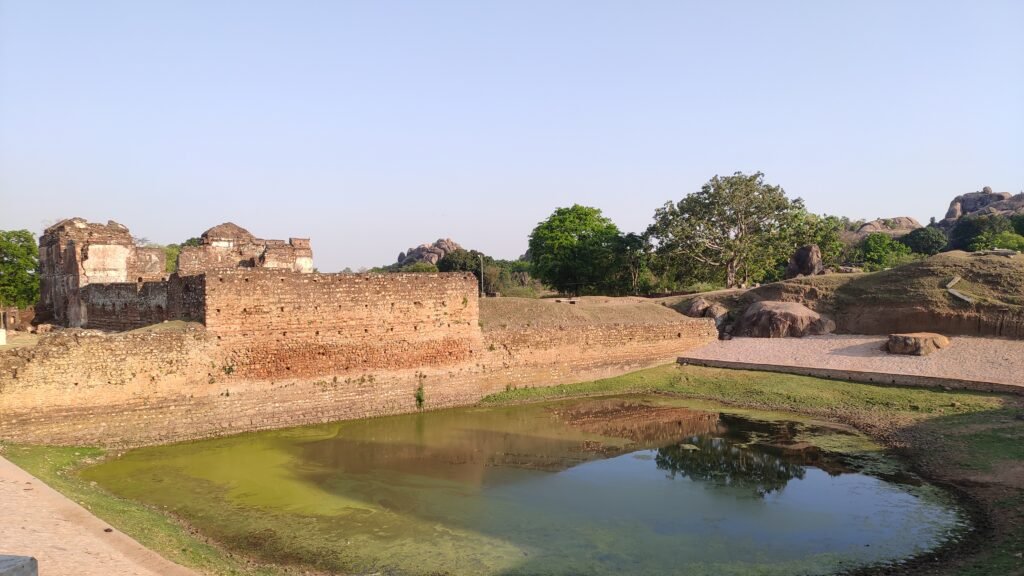Deep within the rugged hills of Jharkhand’s Gumla district, about 70 kilometers south-west of Ranchi, lies a hauntingly beautiful ruin—the once-glorious Navratangarh Palace. Now reduced to weathered stone, encroaching vegetation, and time-worn bricks, it was once the fortified seat of power of one of India’s longest-surviving dynasties—the Nagvanshis of Chota Nagpur, whose rule began in the 1st century CE and continued, in one form or another, until the mid-20th century.
The Tribal Roots of Royalty
The origins of the Nagvanshi dynasty are steeped in both mythology and anthropological history. According to the Nagvansabali, a family chronicle later abstracted and published by Rakhal Das Haldar in 1928, the dynasty was founded by Phani Mukut Rai in 64 CE. He was the adopted son of Madra Munda, a tribal chief of Suitiambe, and is believed to have been born of a mystical union between Pundarik Nag (a serpent deity) and Parvati, a Brahmin woman.
The legend narrates that Pundarik, a descendant of the mythical Takshak Nag of Gandhara, took refuge in Kashi and later migrated to Jharkhand, where his son Phani Mukut Rai was raised by the Brahmin Janardan and accepted by the local Munda chief as the rightful ruler. This blending of tribal and Brahmanical traditions laid the cultural foundation of the Nagvanshi dynasty, symbolizing the intersection of indigenous governance and Hindu royal customs.
From Forests to Fortresses: Evolution of a Dynasty
For centuries, the Nagvanshis ruled from the forested heartlands of Chota Nagpur, living in modest mud or stone dwellings like their tribal subjects. The name ‘Chutia Nagpur’—later anglicized to ‘Chota Nagpur’—appears to derive from ‘Chutia’, a town that served as an early capital under the fourth Nagvanshi king. By the time of Mughal Emperor Akbar, Chota Nagpur was known as ‘Kokrah’ and described as part of the wild, untamed ‘Jharkhand’—literally, ‘forest land’.
It was only in the 17th century, under the ambitious reign of Durjan Sal, that the Nagvanshis transitioned from tribal chieftains to fortified monarchs.
Durjan Sal and the Mughal Entanglement
Durjan Sal, the 45th king in the Nagvanshi lineage, came to power during a turbulent era of Mughal expansion. Refusing to pay tribute to the empire, he incurred the wrath of Ibrahim Khan, the Mughal governor of Bihar, who invaded Kokrah in 1616. Durjan Sal, his family, and his wealth—particularly his famed diamonds—were seized. He was imprisoned in the Gwalior Fort for twelve long years.
But Durjan Sal’s story didn’t end in a Mughal cell. In a dramatic turn of events, Emperor Jahangir summoned the captured king to test his knowledge of gemstones. Durjan Sal correctly identified a genuine diamond from a pair, impressing the emperor, who restored his kingdom, returned his wealth, and even allowed him ceremonial privileges like sitting on a chair in the emperor’s court—an honor rarely granted to vassal kings.
The Birth of Navratangarh
Freed and reinvigorated, Durjan Sal returned to Chota Nagpur in 1627. Recognizing the vulnerability of Kokrah, he relocated his capital to Doisa (also called Doisagarh), a strategically secluded valley ringed by hills on three sides. Here, between 1636 and 1639, he oversaw the construction of the magnificent Navratangarh Palace, assisted by artisans, architects, and royal allies who contributed materials and skilled labor.
Built of brick and stone, the palace was a five-storey marvel—one of the few examples of monumental architecture attributed to a tribal dynasty in Eastern India. Unfortunately, Durjan Sal died shortly after its completion, around 1639 or 1640, but his architectural legacy lived on.
Inside Navratangarh: A Fortified Capital in Ruins
Today, Navratangarh is a poetic ruin. The main palace complex, though crumbling, still reveals hints of its grandeur. The skeletal remains of the once five-storeyed tower dominate the site, its interior rooms now open to the elements. Adjacent structures include a small hall, likely a courtroom or council room, flanked by two smaller chambers. A formal gateway leads into this complex, now framed by silence and the chirping of birds.
To the southwest lies a large tank, still accessible via stairways, once used for ritual bathing and daily utility. Nearby are the ruins of a hexagonal temple and a mansion, possibly for ministers or royals, originally three storeys high.
North of the palace are additional religious structures: a brick temple with a shikhara (tower), an inner sanctum, and a circumambulatory path, suggesting Brahmanical influence. Two ruined stone temples stand nearby—one inscribed with details of its construction by Raja Ragunath Shah (r. 1663–1682) on the advice of Guru Harinath. These inscriptions are crucial to reconstructing the political chronology and religious patronage of the later Nagvanshi kings.
A Dynasty’s Last Days
The capital remained at Doisa until 1724, when Yadunath Shah moved it to Palkote, marking the beginning of the dynasty’s final phase. Under British rule, succession disputes arose. After Jagannath Shah (1818–1860) died without an heir, his nephew Pratap Udainath Shah Deo inherited the throne after protracted legal battles.

Under Pratap’s reign, the Nagvanshi capital moved to Ratu, and a new Ratu Palace was completed in 1933—a colonial-style building still standing today. The final titular ruler was Chintamani Sharan Nath Shahdeo, affectionately remembered as the Ratu Maharaj, a politician and member of the Bihar Legislative Assembly. His death in 2014 marked the end of the ancient Nagvanshi line.
The Living Memory of the Mundas
Even as nature reclaims the stone ruins of Navratangarh, its legacy is not entirely lost. On a recent visit, a group of Munda tribespeople were seen performing a ritual on the palace grounds. Clad in white, they chanted hymns in honor of their ancestors—perhaps maintaining the only continuous link between the 21st century and a 2,000-year-old tribal kingdom.
Conclusion: A Forgotten Jewel of Jharkhand
Navratangarh is more than a historic site—it is a palimpsest of tribal identity, resistance, and sovereignty. It represents a unique confluence of mythology, Mughal diplomacy, local governance, and cultural synthesis. While historians often focus on mainstream dynasties of Delhi or Bengal, Navratangarh reminds us that the heart of India has always had its own kings, its own grandeur, and its own history—quietly enduring in the shadows of the sal forests.
